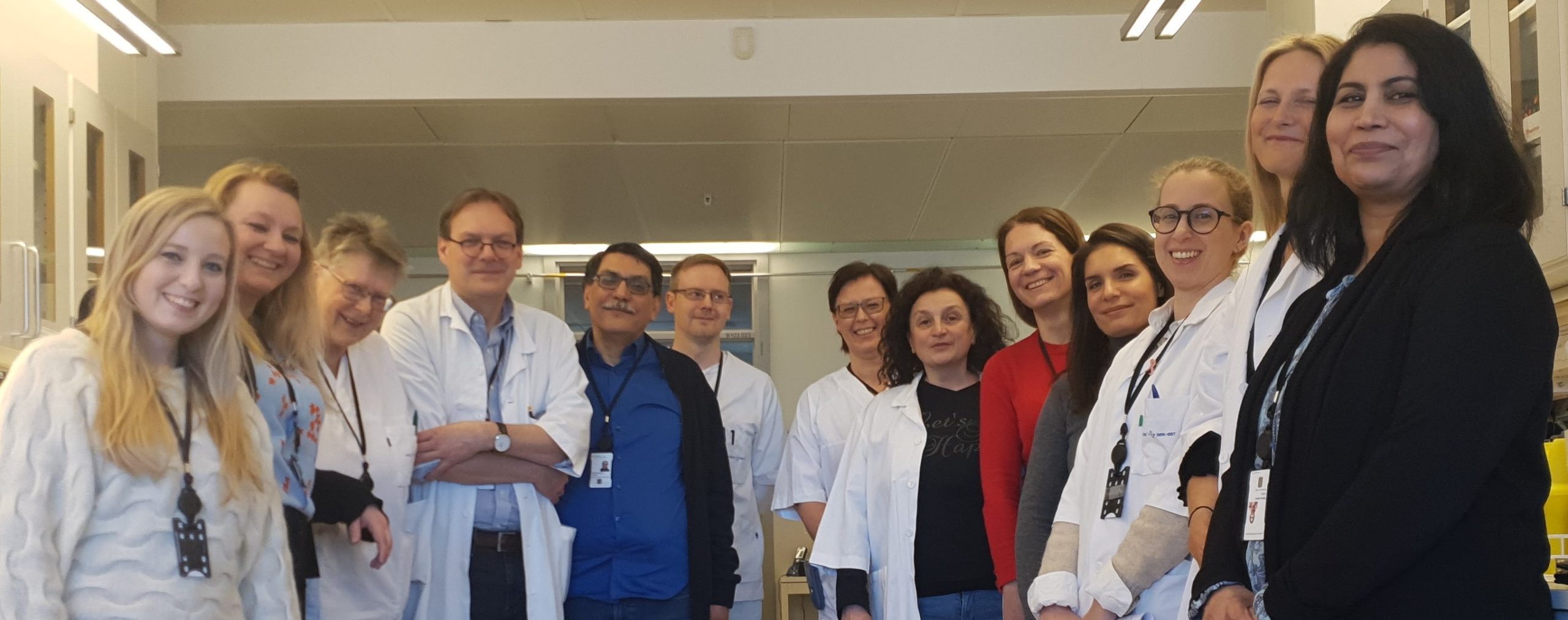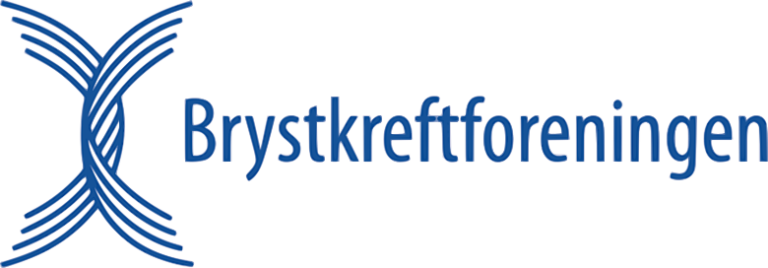Akershus Universitetssykehus
Translational Cancer Research Group, Akershus University Hospital & Institute of Clinical Medicine, University of Oslo, Norway
Our research group has been established in 2008 at the Akershus University Hospital and is working on typical translational cancer research projects covering breast cancer as the main topic, but touching also on various other cancer types, including melanoma and uro-genital cancers. Through translational research, our aim is to identify better strategies to implement personalized cancer treatment.

Group participants (from left to right): Lilly Anne Torland (PhD candidate), Andliena Tahiri (PhD, postdoc), Torill Sauer (professor emerit., UiO, pathologist), Jürgen Geisler (Group leader, professor UiO, senior consultant, oncology), Vahid Bemanian (senior scientist, PhD), Per Christian Sæther (postdoc), Christin Johansen (research nurse), Vessela Kristensen (Co-group leader, PhD, professor, UiO), Jovana Klajic (PhD, postdoc), Nazli Bahrami (PhD student), Joana Reis (radiologist, PhD candidate), Hilde Presterud Ødegård, senior consultant, oncology; Shakila Jabeen (PhD, postdoc). Not present in the picture: Jan Oldenburg (Professor UiO, senior consultant, oncology), Joel Touma (PhD candidate), Stephanie Beate Geisler (M.D., Senior consultant and section leader, oncology, AHUS);
Our main topics of ongoing research are:
1. Breast cancer research
The research involves studying various factors driving the development and progression of breast cancer, and performs integrative analysis using data from various «omic» layers such as microRNA, gene expression, DNA mutations, methylation amongst others. Hormone dependent breast cancer has been one of our main fields of research for many years, and we have initiated two clinical trials at Ahus, NEOLETEXE and NEOLETRIB (PI: Jürgen Geisler). Our projects try in particular to clarify the role of CYP19 (aromatase) in breast cancer biology and treatment including mechanisms of resistance and application of aromatase inhibitors in combination with novel therapeutic approaches (CDK4/6-inhibitors etc.). We work together with many of the established scientific groups focusing on hormone-dependent breast cancer on a global scale to obtain synergy and clinically relevant insights. Selected publications are given here: [1-15].
2. Cardio-Oncology
Modern adjuvant chemotherapy for early breast cancer may harm the heart in the long run and our studies intend to introduce cardio-protective drugs while standard adjuvant chemotherapy is given to our patients. The PRADA-I trial has been published and demonstrated that cardioprotective effects can be easily implemented in oncological treatment algorithms avoiding some of the unintended negative effects on the heart. This project is an ongoing collaboration with the research group of Prof. T. Omland at AHUS. Our new clinical trial ”PRADA-II” is currently recruiting patients with early BC at AHUS and several other University Hospitals in Norway. Selected publications are enclosed: [16- 19].
3. Virusinfections and carcinogenesis
Increasing evidence suggests a role of virus infections in breast cancer carcinogenesis and progression. We collaborate with the research group headed by Prof. Cecilia Södergren at the Karolinska Institute in Stockholm, Sweden. Our research has confirmed a potential role of HCMV-infections on the clinical phenotype of BC. We are currently performing a series of cell culture investigations to study the basic effects of HCMV-infections on breast cancer cell lines. Selected publications from the recent years: [20].
4. Biology of malignant melanomas
Our melanoma research projects are performed mainly using prospective clinical biobanks trying to solve relevant issues correlated to basic melanoma biology, like impact of somatic and germline mutations in biology etc. Together with our collaborators at the University of Lund, Sweden, we have published some basic characterisations of melanoma subgroups with a potential impact on clinical decision making. An ongoing collaboration with the research group of Prof. P.E. Lønning and Stian Knappskog, PhD, (University fo Bergen, Norway) is focussing on genes involved in hereditary malignant melanomas in Norway. Key publications from the recent years: [21-31].
5. Uro-genital cancer
The projects involving uro-genital cancers are led by Professor Jan Oldenburg. He is a specialist in oncology, highly specialized in uro-genital subgroups of cancer. Long-term toxicity after curative treatment of testicular cancer, a field considered a model for late effects research has been Oldenburg´s primary field of expertise. Furthermore, his research is focused on biomarker identification in prostate cancer through clinical studies, and he has started a consortium (the Norwegian Prostate cancer consortium, NPCC) where the focus is to identify and benefits of PSA screening as well as optimal treatment and follow up of prostate cancer patients.
Our key group members at AHUS are:
- Prof. J. Geisler, MD, PhD, medical oncologist at Akershus University Hospital (AHUS); (head);
- Prof.. Torill Sauer, MD, PhD, pathologist at AHUS;
- Katja Vetvik, breast cancer surgeon, AHUS;
- Berit Gravdehaug, breast cancer surgeon, AHUS;
- Joanna Gundersen, breast cancer surgeon, AHUS;
- Siri Strøm Engebretsen, breast cancer surgeon, AHUS;
- Vahid Bemanian, PhD, molecular biologist and senior researcher,department of gene echnology at AHUS;
- John Christopher Noone, molecular biologist, AHUS;
- Hilde Ødegård, medical oncologist, AHUS;
- Ingeborg Vestøl, medical oncologist, AHUS;
- Jan Øyvind Kvaløy, medical oncologist, AHUS;
- Stephanie Beate Geisler, medical oncologist, AHUS;
- Jonas C. Lindstrøm, medical statistician, AHUS;
- Joel Touma, surgeon, AHUS (PhD-candidate);
- Nazli Bahrami, surgeon, AHUS (PhD-candidate);
- Marie Loeng, study nurse, EPIGEN, AHUS;
- Annika Lorentzen, study nurse, EPIGEN, AHUS;
- Unn-Cathrin Buvarp, research nurse, Dep. of Oncology, AHUS;
- Andliena Tahiri, Phd, Postdoc, EPIGEN, AHUS;
- Shakila Jabeen, Phd, Researcher, EPIGEN, AHUS;
Associated group members:
- Prof. Torbjørn Omland, cardiologist, AHUS;
- Prof. Jonn Terje Geitung, Department of Radiology, AHUS;
- Meh Sameen Nawaz, Phd, Associate professor, Høyskolen i Kristiania
- Torben Lüders, PhD, EPIGEN research center, AHUS;
- Shakila Jabeen, PhD, molecular biologist, EPIGEN, AHUS;
- Geeta Gulati, PhD, cardiologist, AHUS
- Kjetil Steine, PhD, cardiologist, AHUS
Important research collaborators in Norway:
- Professor Vessela N. Kristensen, Oslo University Hospital, Ullevål, Oslo, Norway
- Professor Per Eystein Lønning, MD, PhD, Haukeland University Hospital, Bergen Norway;
- Stian Knappskog, PhD, Haukeland University Hospital & University of Bergen, Norway;
- Xavier Tekpli, Oslo University Hospital, Ullevål, Oslo, Norway
- RESCUER 2020 Consortium
- OSBREAC (OSLO BREAST CANCER COLLABORATION);
Pivotal international collaborators:
- Professor Shiuan Chen, City of Hope National Cancer Center, Duarte, CA, USA;
- Professor Cecilia Södergren, Karolinska Institute, Stockholm, Sweden;
- Professor Hironobu Sasano, Sendai University, Japan;
- Professor Jason Carroll, University of Cambridge, UK;
- Professor Åke Borg, and Göran Jönsson, University of Lund, Sweden;
- Charlie Vaske, PhD, Nantomics Inc., Culver City, Los Angeles, CA, USA;
Correspondence:
Professor Jürgen Geisler, M.D., PhD, Department of Oncology, Akershus University Hospital & Institute of Clinical Medicine, University of Oslo, Norway;
Selected references:
- Flageng MH, Larionov A, Geisler J et al. Treatment with aromatase inhibitors stimulates the expression of epidermal growth factor receptor- 1 and neuregulin 1 in ER positive/HER-2/neu non-amplified primary breast cancers. J Steroid Biochem Mol Biol 165(Pt B), 228-235 (2017).
- Daldorff S, Mathiesen RM, Yri OE, Odegard HP, Geisler J. Cotargeting of CYP-19 (aromatase) and emerging, pivotal signalling pathways in metastatic breast cancer. Br J Cancer 116(1), 10-20 (2017).
- Geisler J. Differences between the non-steroidal aromatase inhibitors anastrozole and letrozole–of clinical importance? Br J Cancer 104(7), 1059-1066 (2011).
- Lonning PE, Geisler J. Evaluation of plasma and tissue estrogen suppression with third-generation aromatase inhibitors: of relevance to clinical understanding? J Steroid Biochem Mol Biol 118(4-5), 288-293 (2010).
- Haynes BP, Straume AH, Geisler J et al. Intratumoral estrogen disposition in breast cancer. Clin Cancer Res 16(6), 1790-1801 (2010).
- Geisler J, Suzuki T, Helle H et al. Breast cancer aromatase expression evaluated by the novel antibody 677: correlations to intra-tumor estrogen levels and hormone receptor status. J Steroid Biochem Mol Biol 118(4-5), 237-241 (2010).
- Lonning PE, Helle H, Duong NK, Ekse D, Aas T, Geisler J. Tissue estradiol is selectively elevated in receptor positive breast cancers while tumour estrone is reduced independent of receptor status. J Steroid Biochem Mol Biol 117(1-3), 31-41 (2009).
- Flageng MH, Moi LL, Dixon JM et al. Nuclear receptor co-activators and HER-2/neu are upregulated in breast cancer patients during neo-adjuvant treatment with aromatase inhibitors. Br J Cancer 101(8), 1253-1260 (2009).
- Lonning PE, Geisler J. Aromatase inhibitors: assessment of biochemical efficacy measured by total body aromatase inhibition and tissue estrogen suppression. J Steroid Biochem Mol Biol 108(3-5), 196-202 (2008).
- Lonning PE, Geisler J. Experience with exemestane in the treatment of early and advanced breast cancer. Expert Opin Drug Metab Toxicol 4(7), 987-997 (2008).
- Geisler J, Helle H, Ekse D et al. Letrozole is superior to anastrozole in suppressing breast cancer tissue and plasma estrogen levels. Clin Cancer Res 14(19), 6330-6335 (2008).
- Geisler J. Aromatase inhibitors: from bench to bedside and back. Breast Cancer 15(1), 17-26 (2008).
- Geisler J, Haynes B, Ekse D, Dowsett M, Lonning PE. Total body aromatization in postmenopausal breast cancer patients is strongly correlated to plasma leptin levels. J Steroid Biochem Mol Biol 104(1-2), 27- 34 (2007).
- Geisler J, Lonning PE. Aromatase inhibition: translation into a successful therapeutic approach. Clin Cancer Res 11(8), 2809-2821 (2005).
- Geisler J. Breast cancer tissue estrogens and their manipulation with aromatase inhibitors and inactivators. J Steroid Biochem Mol Biol 86(3-5), 245-253 (2003).
- Heck SL, Gulati G, Hoffmann P et al. Effect of candesartan and metoprolol on myocardial tissue composition during anthracycline treatment: the PRADA trial. Eur Heart J Cardiovasc Imaging doi:10.1093/ehjci/jex159 (2017).
- Gulati G, Heck SL, Rosjo H et al. Neurohormonal Blockade and Circulating Cardiovascular Biomarkers During Anthracycline Therapy in Breast Cancer Patients: Results From the PRADA (Prevention of Cardiac Dysfunction During Adjuvant Breast Cancer Therapy) Study. J Am Heart Assoc 6(11), (2017).
- Gulati G, Heck SL, Ree AH et al. Prevention of cardiac dysfunction during adjuvant breast cancer therapy (PRADA): a 2 x 2 factorial, randomized, placebo-controlled, double-blind clinical trial of candesartan and metoprolol. Eur Heart J 37(21), 1671-1680 (2016).
- Heck SL, Gulati G, Ree AH et al. Rationale and design of the prevention of cardiac dysfunction during an Adjuvant Breast Cancer Therapy (PRADA) Trial. Cardiology 123(4), 240-247 (2012).
- Rahbar A, Touma J, Costa H et al. Low Expression of Estrogen Receptor- alpha and Progesterone Receptor in Human Breast Cancer Tissues Is Associated With High-Grade Human Cytomegalovirus Protein Expression. Clin Breast Cancer doi:10.1016/j.clbc.2017.04.013 (2017).
- Birkeland E, Zhang S, Poduval D et al. Patterns of genomic evolution in advanced melanoma. Nat Commun 9(1), 2665 (2018).
- Loes IM, Immervoll H, Angelsen JH et al. Performance comparison of three BRAF V600E detection methods in malignant melanoma and colorectal cancer specimens. Tumour Biol 36(2), 1003-1013 (2015).
- Lauss M, Ringner M, Karlsson A et al. DNA methylation subgroups in melanoma are associated with proliferative and immunological processes. BMC Med Genomics 8 73 (2015).
- Lauss M, Haq R, Cirenajwis H et al. Genome-Wide DNA Methylation Analysis in Melanoma Reveals the Importance of CpG Methylation in MITF Regulation. J Invest Dermatol 135(7), 1820-1828 (2015).
- Tahiri A, Roe K, Ree AH et al. Differential inhibition of ex-vivo tumor kinase activity by vemurafenib in BRAF(V600E) and BRAF wild-type metastatic malignant melanoma. PLoS One 8(8), e72692 (2013).
- Geisler J, Bachmann IM, Nyakas M et al. Malignant melanoma–diagnosis, treatment and follow-up in Norway. Tidsskr Nor Laegeforen 133(20), 2154-2159 (2013).
- Birkeland E, Busch C, Berge EO et al. Low BRAF and NRAS expression levels are associated with clinical benefit from DTIC therapy and prognosis in metastatic melanoma. Clin Exp Metastasis 30(7), 867-876 (2013).
- Harbst K, Staaf J, Lauss M et al. Molecular profiling reveals low- and high- grade forms of primary melanoma. Clin Cancer Res 18(15), 4026-4036 (2012).
- Jonsson G, Busch C, Knappskog S et al. Gene expression profiling-based identification of molecular subtypes in stage IV melanomas with different clinical outcome. Clin Cancer Res 16(13), 3356-3367 (2010).
- Busch C, Geisler J, Lillehaug JR, Lonning PE. MGMT expression levels predict disease stabilisation, progression-free and overall survival in patients with advanced melanomas treated with DTIC. Eur J Cancer46(11), 2127-2133 (2010).
- Knappskog S, Geisler J, Arnesen T, Lillehaug JR, Lonning PE. A novel type of deletion in the CDKN2A gene identified in a melanoma-prone family. Genes Chromosomes Cancer 45(12), 1155-1163 (2006).





















